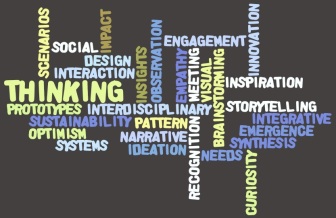 A recently scheduled FREE webinar from MRT has got me thinking about creativity and the optimal conditions that fuel it. The webinar is about Design Thinking, an approach towards product development that guides one to uncover the root of the customer’s problem that your product or service solves.
A recently scheduled FREE webinar from MRT has got me thinking about creativity and the optimal conditions that fuel it. The webinar is about Design Thinking, an approach towards product development that guides one to uncover the root of the customer’s problem that your product or service solves.
Along the way, I stumbled upon an article called “Design Thinking is a Failed Experiment” by Bruce Nussbaum, perhaps best known as a managing editor at BusinessWeek, where he declares the decade of Design Thinking to be closing. But is he a credible enough authority to make said declaration? Of course he is, because he has a new drum to beat called “Creative Intelligence.” Even innovation methods need to be refreshed to look innovative again. It’s a “meta” thing.
There was one piece of Nussbaum’s article that caught my attention. The factor that he says marginalized corporate implementations of Design Thinking methods is that:
Companies absorbed the process of Design Thinking all to [sic] well, turning it into a linear, gated, by-the-book methodology that delivered, at best, incremental change and innovation. Call it N+1 innovation. CEOs in particular, took to the process side of Design Thinking, implementing it like Six Sigma and other efficiency-based processes.
This is something not enough people realize when they talk about “best practices.” With best practices, the standard warning is that copying does not work, one must customize best practices to the culture, environment, industry, etc. In fact, one should probably utilize Design Thinking in order to properly implement Design Thinking.
Companies often don’t follow this advice, however, or they take it the wrong way and customize so much of the practice that its benefits are also removed as part of the process. This is similar to how hospital patients often contract diseases like staph infections as an unintended consequence of trying to be cured.
In relation to Design Thinking, what Nussbaum means is that creativity often requires a lack of structure, a type of chaos if you will, to illuminate an insightful solution. According to him, once the “suits” got a hold of it, they threw the baby out with the bath water. Corporations and their HR departments are known for over complicating things as simple as a #2 pencil requisition procedure.
This does not necessarily mean that Design Thinking is a “failed experiment,” as Nussbaum asserts. It does, however, point to a leadership failure that can cripple even the smartest corporation. Once again, this famous saying gets pulled out from the bag, as an old business Yoda used to hammer into me, “a fool with a tool is still a fool.” Please don’t be that fool.
Want to learn more about Design Thinking?
Join us for MRT’s FREE Webinar:
“Design Thinking: Extreme Customer-Driven Innovation”
Wednesday, August 22, 2012
Just found a rebuttal to Bruce’s postion on the death of DT – http://www.fastcodesign.com/1665384/is-design-thinking-dead-hell-no?goback=.anb_37821_*2_*1_*1_*1_*1_*1.gmp_37821.gde_37821_member_79879362
I love this posting, there’s a lot of wisdom here. I especially love the quote from Nussbam about turning Design Thinking into a linear process. In fact, I feel this is why Design Thinking is so necessary, and it would be a shame and a waste to try to turn it into another Six Sigma process. Getting caught up in this kind of thinking loses sight of what Six Sigma, and manufacturing are meant for. They’re meant for predictability and uniformity of results, noble and important goals for problems that have been SOLVED.
But the creative process, if its to be one that is truly inventive and ground breaking, by its very nature can not be predictable or uniform. While I don’t think the alternative is only chaos, I do think the alternative is to better understand the creative process and how it works. It means being comfortable with being lost sometimes. It means learning that sometimes you don’t even know what the questions are, let alone the answers. It means that at times it will only be intuition that can guide you. Although that intuition is often guided by deep experience and understanding.
This leaves some people very uncomfortable “I’m supposed to leave the fate of my company to something as vague as intuition?” Well, if you think about it, most leaders do go on their own intuition. They gather up facts, and then they use their “guts” to make a decision. Designers do the same thing. With different “facts”.
What Design Thinking, at its best, seeks to do, is to put together the right circumstances, the right people, right support systems, and the right resources, so that the creative process can do its best. It can be scary at times, its not for the feint of heart. But done right, it works.